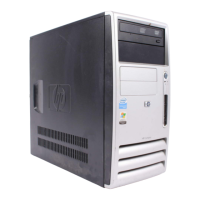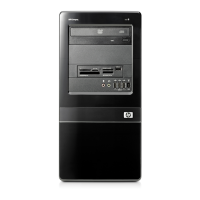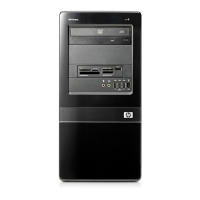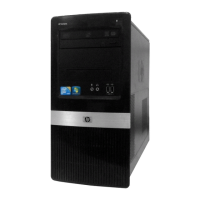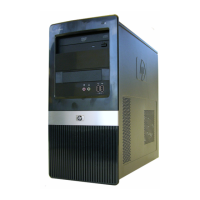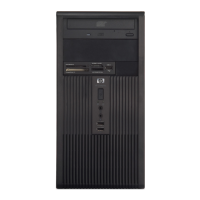Serviceability Features of System
Dual Color Power LED on Front of Computer (Indicates Normal Operations and Fault Conditions)
Diagnostic LED Explanation Table
Number of 1-second red LED blinks followed by 2-second pause, then repeats:
2-processor thermal protection activated
3-processor not installed
4-power supply failure
5-memory error
6-video error
7-PCA failure (ROM detected failure prior to video)
8-invalid ROM, bootblock recover mode
System/Emergency ROM
Flash ROM
CMOS Battery Holder for easy
Replacement
Flash Recovery with Video
Configuration Record SW
5 Aux Power LED on System PCA
Processor ZIF Socket for easy Upgrade
Over-Temp Warning on Screen
(Requires IM Agents)
Clear Password Jumper
DIMM Connectors for easy Upgrade
HP Backup and Recovery Manager
Clear CMOS Button
NIC LEDs (integrated) (Green & Amber)
Serviceability Features of Chassis
Dual Color Power and HD LED – To
Indicate Normal Operations and
Fault Conditions
Color coordinated cables and
connectors
Tool-less Hood Removal
Front power switch
System memory can be upgraded
without removing the system board or
any internal components
Tool-less Hard Drive, CD & Diskette
Removal
Green Pull Tabs, and Quick
Release Latches for easy
Identification
Tool-less System Board Removal
Feature
Description
ASF 2.0 support (Alert Standard Format)
Industry-standard specification for network alerting in operating system-absent
environments
Drive Lock*
Implementation of the industry standard ATA Security feature set. When enabled, it prevents
software access to user data on the drive until one or two user-defined passwords are
provided.
Drive Self Tests (DPS)*
Drive Protection System
A diagnostic hard drive self test. It scans critical physical components and every sector
of the hard drive for physical faults and then reports any faults to the user.
Running independently of the operating system, it can be accessed through a
Windows-based diagnostics utility or through the computer's setup procedure. It
produces an evaluation on whether the hard drive is the source of the problem and
needs to be replaced.
The system expands on the Self-Monitoring, Analysis, and Reporting Technology
(SMART), a continuously running systems diagnostic that alerts the user to certain
types of failures
DPS Access through F10 Setup during
Boot
SMART Technology*
(Self-Monitoring, Analysis and Reporting
Technology)
Allows hard drives to monitor their own health and to raise flags if imminent failures were
predicted
QuickSpecs
HP Compaq dx7300 Business PC
Technical Specifications
DA - 12583 Worldwide — Version 15 — September 19, 2007
Page 19
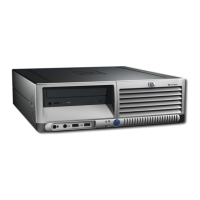
